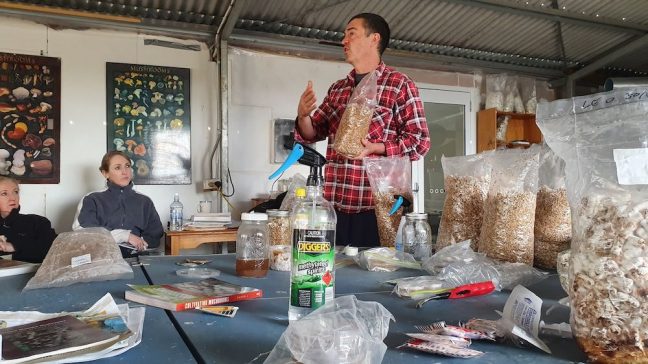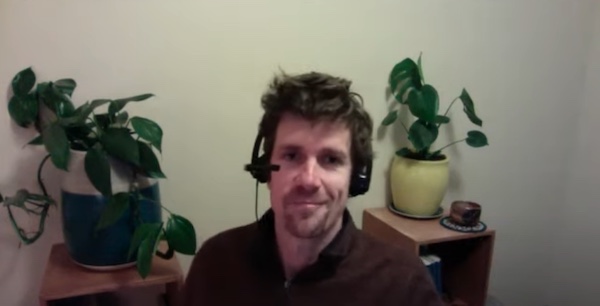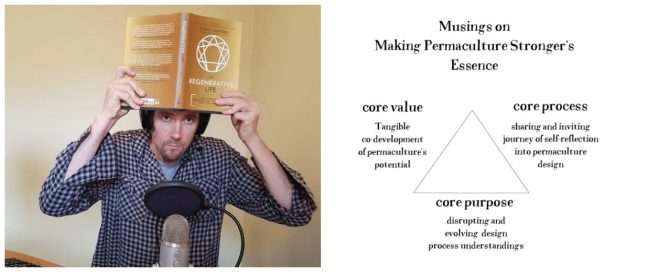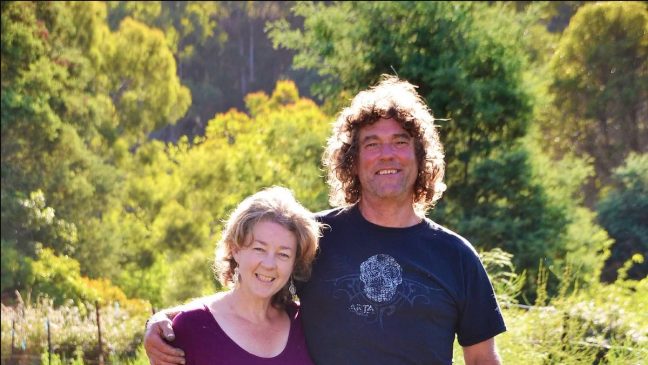Thanks so much to everyone who attended the webinar, and thanks to Linda and Trevor for their time!
Watch the replay below and don’t forget to sign up for the next one!
Thanks so much to everyone who attended the webinar, and thanks to Linda and Trevor for their time!
Watch the replay below and don’t forget to sign up for the next one!

Join mushroom expert Will Borowski for a lively discussion presented and hosted by Permaculture Tasmania on growing mushrooms in your own home.
Which types to start with? What can you grow them on? During the webinar, you will have the opportunity to ask all your questions directly of Will.
Will has been growing mushrooms professionally as well as teaching mushroom cultivation around the world for almost twenty years. He is the proprietor of Forest Fungi.
Permaculture Tasmania’s Winter Webinar Series is a collection of live recorded discussions with experts and thought leaders on topics related to permaculture, gardening and regenerative design. They are hosted by PT thanks to the support of our membership, but are available to anyone interested in these subjects. So please feel free to share them far and wide!
Here is the link to register for the webinar. Registration is free but required. And if you sign-up now, Zoom will add a reminder to your calendar.

Thanks so much to everyone who attended the webinar, and thanks to Dan for his time!
Watch the replay below and don’t forget to sign up for the next one!

Join podcaster, theorist and permaculture designer, Dan Palmer, for a discussion and Q&A on permaculture’s strengths and shortcomings, how the movement has evolved and what we all would like to see happen next.
Is the future of the movement suburban? Is it broad acre? Wither the herb spiral? Register below and find out!
Permaculture Tasmania’s Winter Webinar Series is a collection of live recorded discussions with experts and thought leaders on topics related to permaculture, gardening and regenerative design. They are hosted by PT thanks to the support of our membership, but are available to anyone interested in these subjects. So please feel free to share them far and wide!
Here is the link to register for the webinar. Registration is free but required. And if you sign-up now, Zoom will add a reminder to your calendar.

Join Linda and Trev -the dynamic duo behind Seed Freaks– for a timely conversation on seeds and seed saving. Not only the ‘how to’, but also the ‘why to’. This will be followed by a Q&A where you will have the opportunity to ask Linda and Trev any and all questions you may have on seed saving and seed starting.
Permaculture Tasmania’s Winter Webinar Series is a collection of live recorded discussions with experts and thought leaders on topics related to permaculture, gardening and regenerative design. They are hosted by PT thanks to the support of our membership, but are available to anyone interested in these subjects. So please feel free to share them far and wide!
Here is the link to register for the webinar. Registration is free but required. And if you sign-up now, Zoom will add a reminder to your calendar.
Permaculture Tasmania member and PT social media volunteer Lisa, recently guided us through a virtual tour of her yard, and systems she uses to grow food and obtain a yield.
Lisa’s urban property is a 10 minute bike ride from the Hobart CBD, in the foothills of kunanyi.
The property is approx. 1200 metres squared and on a steep southerly slope and consists of habitat for wildlife, a food forest, raised vegetable beds, a green house, compost bins, worm farms, chickens and quail. In this virtual tour you will get insights into all these areas.

Contributors: Alexia and Karen (Transition Tamar)
Did you know a new Transition group has formed in the North?
Transition Tamar kindly provided some details about how they started, who they are, what they hope to do. Oh, and there is a BIG permaculture connection…
Way back in (what seems a decade ago) 2018, David Holmgren (you’ve probably heard of him) visited Launceston as part of the tour for his new book ‘Retrosuburbia’, and at the presentation a handful of people put their names down to say they were interested in forming a Retrosuburbia book club. A particularly brave soul offered to host strangers in her house, and the date was set: the first few chapters of ‘Retrosuburbia’ were read, the host cleaned house and cooked a few pizzas, and then… one of the eight invitees arrived with her daughter – but nobody else made it along. After some delicious food and good conversation, the two decided to try once more, listing an event on our local permaculture facebook page to see if anyone was interested… and this time twelve people came together, bringing amazing food, drink, flowers, produce, seeds, connection and conversation about how to live more sustainably.
As we got to know each other, it turned out that at least half of our book club members had moved to Tasmania from mainland Australia over the last few years, with the hope of living a lifestyle that would reduce their carbon footprint and make a difference to climate change. As we continued to meet, one spring afternoon – a year after David’s presentation – a small speech and a nervous invitation to gather for a different reason was made by one of the members: how did we feel about doing SOMETHING? Would people consider gathering to explore Transition and whether it was something they’d like to be involved with?
Transition Tamar was formed over more food, videos and discussion – everyone who ended up being involved being super-passionate about what we could do to bring community with us on this journey. In that spirit, after only three meetings, an open invitation to the permaculturalists gathering at the Launceston PDC earlier this year (also feels like a decade ago!) was made, and our Committee literally doubled overnight! This extended group only got the chance to meet twice before lockdown occurred, but Transition Tamar has leant on the resilience and adaptability that Holmgren’s book is saturated in, and moved swiftly online, meeting fortnightly since to continue organising the “unleashing”, co-ordinate grant applications, relate conversations with councils, like-minded organisations & people, brainstorm publicity opportunities and move ahead with initiatives that we can launch even if we are still in isolation. Our ideas for ways to bring food, beauty, connection and wellbeing to our community still remain, we just have to be more patient or more creative about how we go about them. In that spirit, a decision was made to start a Facebook group to reach out to community and start sharing ideas whilst we couldn’t meet in person. From a tiny book club meeting, to the seeds of hope for a more resilient community, to launching online in a time of crisis. What a rollercoaster!
Transition Tamar still hope to unleash later this year. We are the local face of a worldwide movement co-created only a little over ten years ago by an English permaculture teacher called Rob Hopkins (you’ve probably heard of him too). Local groups, networked together, but on their own trajectories to create resilient communities around our world in response to the climate and ecological emergencies facing us. Transition communities adapt to the changing environment through skill-sharing, sustainable living, localised food production, circular economies and regenerative development. If it is good for the community and the planet we are for it! If it feels familiar to you, it should be: Transition has been described as permaculture on steroids!
If you live in the following municipalities (Launceston, West Tamar, Georgetown) we would love to have you join our fledgling community online whilst we are in lockdown. You can find us on Facebook at: https://www.facebook.com/Transition-Tamar-100482251613946/
Residents of these councils are also eligible to vote for us in the Regional City Challenge: https://launcestontogether.com.au/activity/the-great-regional-city-challenge where we have put an application in for some funding to help us launch and start projects – we’d love your support! Voting closes May 31st.
We hope to keep you regularly updated through the space being so generously made for us in Permaculture Tasmania’s newsletter. If it wasn’t for the people at Permaculture Tas organising David Holmgren’s book tour, this page would likely be blank, 12 friends would not have met, and the communities along our beautiful Tamar Valley would not be able to look forward to coming together later this year to plan a transition to a low-carbon, connected community for all. Thanks PT ☺️
With Covid-19 we’re all having to change the way we engage with each other to ensure everyone stays safe. As per Tas govt. regulations, PT face to face activities have already ceased.
Many will be doing food swaps/barters or sharing of goods and services such as books, tools etc. through their networks, which is a big part of permaculture ethics & community.
Please continue to follow Covid safety including hand hygiene (wash/sanitise before/after handling items), contactless drop/swap and not engaging in swaps at all if you are unwell or have potentially been exposed.
For a good explanation of how the virus can be transmitted via surfaces click here – it goes into decent depth about the risks for different surfaces.
Take into account the travel & ‘stay at home’ regulations that are in place and we encourage members to check out the Tas govt regulations when making decisions about what they can/can’t do safely. https://www.coronavirus.tas.gov.au/families-community/gatherings/gatherings-faqs
The PT Committee and local groups are working on a number of activities to keep folks engaged, share skills & knowledge, and continue building community resilience in the coming months. Stay tuned or get in touch sooner if you have an idea for activities too
Stay safe – and if any queries get in touch with the team via [email protected]. Thanks for your support to PT and being a part of our great community 🙂
Contributors: Lauren & Oberon Carter at Spiral Garden

In January we hosted a cob oven workshop in our backyard, organised by Permaculture Tasmania and run by the lovely Clare.
Ten participants learned all the practical goodness and healthy fun of building an oven with natural and secondhand materials we had carefully gathered from as close to home as possible.
We provided nourishment and helped out where we could. Feet danced to mix clay, sand, water and straw, and hands crafted smooth render into beautiful spirals. There is something a bit magical that happens with these sorts of goal-oriented, educational working bees, especially when everyone is dedicated to their task and ‘gets it’. Such good vibes.


There are plans to carry the group forward to help each other build ovens, and probably share some pizza too! We can’t wait to fire our oven when it’s ready in a week or so, and to create a space around our oven for us to enjoy our garden and each other.


We are taking expressions of interest for a suitable venue to host our AGM this year in September. Do you have a wonderful venue you’d like to showcase?
The requirements to host the meeting are as follows:
Mandatory
Desirable
Please email us to obtain an expression of interest form at [email protected] – closing 29 February 2020.